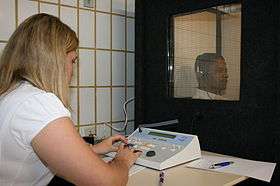Hearing test
| Hearing test | |
|---|---|
 A hearing health professional conducting an audiometric hearing test in a sound-proof testing booth | |
| ICD-9-CM | 95.41 |
A hearing test provides an evaluation of the sensitivity of a person's sense of hearing and is most often performed by an audiologist using an audiometer. An audiometer is used to determine a person's hearing sensitivity at different frequencies. There are other hearing tests as well, e.g., Weber test and Rinne test.
Ear examination
Prior to the hearing test itself, the ears of the client are usually examined with an otoscope to make sure they are free of wax, that the eardrum is intact, the ears are not infected, and the middle ear is free of fluid (indicating middle ear infection). The most common reasons to develop hearing loss due to genetic disorder, ageing problems, exposure to noise pollution, infections, birth complications, trauma to the ear, and certain medications or toxins.
Pure tone audiometry
The standard and most common type of hearing test is pure tone audiometry, which measures the air and bone conduction thresholds for each ear in a set of 8 standard frequencies from 250Hz to 8000Hz. The test is conducted in a sound booth using a pair of headphones connected to an external audiometer. The result of the test is an audiogram diagram which plots a person's hearing sensitivity at the tested frequencies. There is also a high frequency version of the test which tests frequencies over 8000Hz to 16000Hz which may be employed in special circumstances.
Weber and Rinne
A complete hearing evaluation involves several other tests as well.[1] In order to determine what kind of hearing loss is present, a bone conduction hearing test is administered. In this test, a vibrating tuning fork is placed behind the ear, on the mastoid process. When the patient can no longer feel/hear the vibration, the tuning fork is held in front of the ear; the patient should once more be able to hear a ringing sound. If they cannot, there is conductive hearing loss in that ear. Additionally, the tuning fork is placed on the forehead. The patient is then asked if the sound is localised in the centre of the head or whether it is louder in either ear. If there is conductive hearing loss, it is likely to be louder in the affected ear; if there is sensorineural hearing loss, it will be quieter in the affected ear. This test helps the audiologist determine whether the hearing loss is conductive (caused by problems in the outer or middle ear) or sensorineural (caused by problems in the cochlea, the sensory organ of hearing) or neural - caused by a problem in the auditory nerve or auditory pathways/cortex of the brain.
Hearing in Noise
The Hearing in Noise Test (HINT) measures a person's ability to hear speech in quiet and in noise.[2] In the test, the patient is required to repeat sentences both in a quiet environment and with competing noise being presented from different directions. More specifically, there are four conditions: (1) sentences with no competing noise, (2) sentences with competing noise presented directly in front of the patient, (3) noise presented at 90° to the right of the patient, and (4) noise presented at 90° to the left of the patient. The test measures signal to noise ratio for the different conditions which corresponds to how loud the sentences needed to be played above the noise so that the patient can repeat them correctly 50% of the time.
Other
- The audiologist or hearing instrument specialist may also conduct speech tests, wherein the patient repeats the words he or she hears.
- In addition, a test called a tympanogram is generally done. In this test, a small probe is placed in the ear and the air pressure in the ear canal is varied. This test tells the audiologist how well the eardrum and other structures in the middle ear are working. The ear canal volume indicates whether a perforation in the eardrum (tympanic membrane) may be present. The middle ear pressure indicates whether any fluid is present in the middle ear space (also called "glue ear" or "otitis media with effusion"). Compliance measurement indicates how well the eardrum and ossicles (the three ear bones) are moving.
- The last test the audiologist may perform is an acoustic reflex test. In this test a probe is placed in the ear and a loud tone, greater than 70 dBSPL, is produced. The test measures the reflexive contraction of the stapedius muscle, which is important in protecting the ear from loud noises, such as a person's own speech which may be 90 dBSPL at the eardrum. This test can be used to give information about the vestibular and facial nerves and indicate if a lesion may be present.
References
- ↑ Yueh, B; Shapiro N; MacLean CH; Shekelle PG (April 2003). "Screening and management of adult hearing loss in primary care: scientific review". Journal of the American Medical Association. American Medical Association. 289 (15): 1976–1985. PMID 12697801. doi:10.1001/jama.289.15.1976. Retrieved 2007-11-10.
- ↑ Nilsson, M.; Soli, S. D.; Sullivan, J. A. (1994). "Development of the Hearing in Noise Test for the measurement of speech reception thresholds in quiet and in noise". The Journal of the Acoustical Society of America. 95 (2): 1085–1099. PMID 8132902. doi:10.1121/1.408469.
External links
- Online Hearing Test (Audiogram-type)